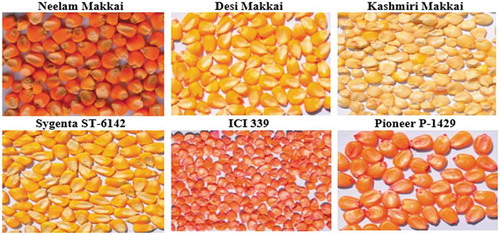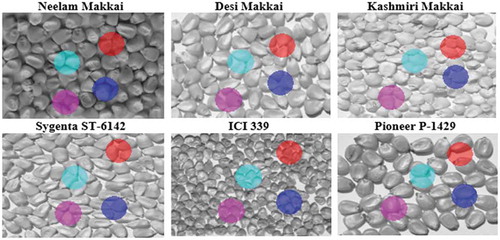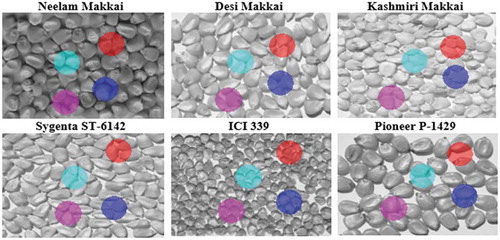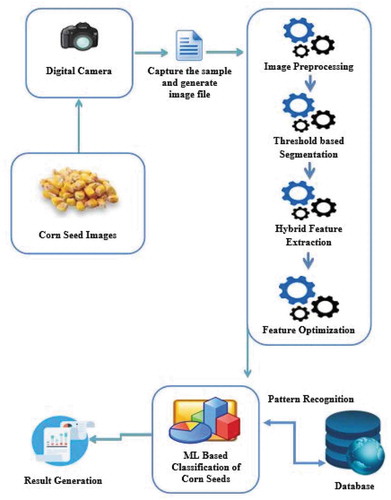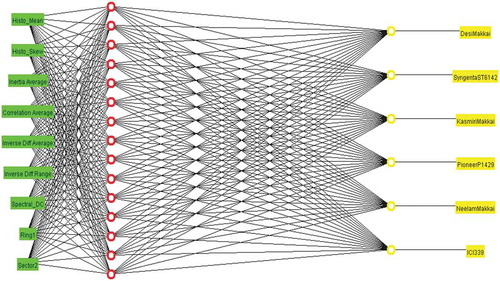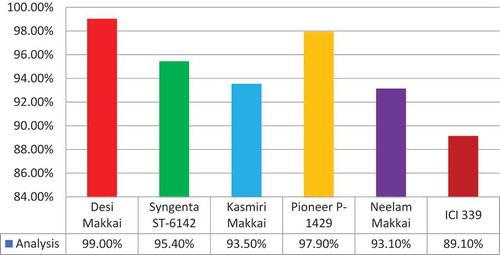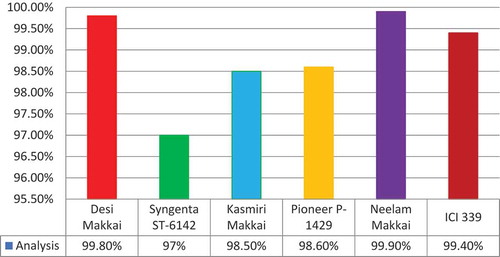 ?Mathematical formulae have been encoded as MathML and are displayed in this HTML version using MathJax in order to improve their display. Uncheck the box to turn MathJax off. This feature requires Javascript. Click on a formula to zoom.
?Mathematical formulae have been encoded as MathML and are displayed in this HTML version using MathJax in order to improve their display. Uncheck the box to turn MathJax off. This feature requires Javascript. Click on a formula to zoom.ABSTRACT
Seed purity is an important indicator of crop seed quality. On the other side, corn is an important crop of the modern agricultural industry with more than 40% grain Worldwide production. The purpose of this study was to examine the feasibility of a machine learning (ML) approach for classifying different types of corn seeds. The seed digital images (DI) of six corn varieties were Desi Makkai, Sygenta ST-6142, Kashmiri Makkai, Pioneer P-1429, Neelam Makkai, and ICI 339. This was achieved through a digital camera in a natural environment without a complicated laboratory system. The acquired DI dataset converted to a hybrid feature dataset, which is the combination of histogram, texture, and spectral features. For each corn seed image, a total of fifty-five hybrid-features was acquired on every non-overlapping region of interest (ROI), sizes (75 × 75), (100 × 100), (125 × 125) and (150 × 150). The nine optimized features have been acquired by employing the correlation-based feature selection (CFS) technique with the Best First search algorithm. To build the classification models, Random forest (RF), BayesNet (BN), LogitBoost (LB), and Multilayer Perceptron (MLP) were employed using optimized multi-feature using (10-fold) cross-validation approach. A comparative analysis of four ML classifiers, the MLP performed outstanding classification accuracy (98.93%), on ROIs size (150 × 150). The accuracy values by MLP on six corn seed verities named Desi Makkai, Sygenta ST-6142, Kashmiri Makkai, Pioneer P-1429, Neelam Makkai, ICI- 339 was 99.8%, 97%, 98.5%, 98.6%, 99.9%, and 99.4%, respectively.
Introduction
Corn is an essential cereal crop for human being that count about 50 species around the world. Corn species are of different sizes, colors, shapes, and textures. Yellow, red, and white corn seeds are the most common categories.[Citation1] In developed countries, 70% of corn is used for animal feed and 5% is consumed as human food. While in developing countries like Pakistan, where the population has increased rapidly, consume about 62% of corn as human food and 34% as animal feed .[Citation2]
In Pakistan (PK), the fourth largest cultivation in corn after wheat, cotton, and rice. The one million hectares land is under the corn crop and producing 3.6 million metric tons yield. Punjab (PK) contributes with 39% of the aggregate zone for corn yield and 30% of aggregate production, Khyber-Pakhtunkhwa (PK) contributes 56.55% of the aggregate zone and 63.5% of aggregate production, while 6% of the aggregate zone and 4% of the aggregate production is supported by Baluchistan and Sindh (PK) .[Citation3]
Corn seed has two types: open-pollinated and hybrid. Open-pollinated corn seeds produce plants whose seeds will produce more plants that will look similar to the parent corn plant. These seeds generated from plants that are normally pollinated. The important reason for planting this type is that mostly non-hybrid corn or open-pollinated corn seeds have better taste. The non-hybrid corn crop is mostly used for animal feed .[Citation4] Hybrid corn is a unique and highly specialized crop. The production of hybrid corn seeds requires more time, expense, and experience to produce than other cereal crops. The production of hybrid corn seeds involves the crossing of two inbred lines that intersect to produce the seed of a variety, hybridization. The two inbred lines utilized in the process called ‘male’ the plant that is responsible for the production of pollen and ‘female’ the plant that creates the hybrid seed. Inbred lines are crossed to make a variety that shows a few qualities, for example, protection from the dry season. Extreme measures are taken throughout the process to ensure the quality and purity of the produced seed .[Citation4]
The analysis and classification of corn seeds are performed to obtain information in the variety, production, and quality of corn seeds. Clean, disease-free and insect-free corn seeds can be described as quality corn seeds. Assurance of the quality and variety of corn seeds are basic procedures for verification. Furthermore, it is the initial step in the operation of processing corn seeds in machines for the separation of corn seeds. The utilization of guaranteed corn seeds expands the quality and amount of yield .[Citation5] In general, for certification, the process of analysis and classification is performed by specialists who utilize the visual attributes of the corn seeds. These regular methods take a long time, very boring, expensive, and depend on the person’s knowledge. Corn seed separating machines perform operations such as determining the properties of corn seeds, identifying corn seed varieties, and identifying corn seed fundamental operations through pattern recognition, image processing .[Citation6] Image processing has been connected to different agricultural products and used to achieve rapid and accurate results. Analysis and classification of corn seeds are performed through image processing .[Citation7] The analysis and classification of seeds provide more information on seed quality, identification of impurities, and their outliers. Moreover, before planting, it is very necessary to check the corn variety, its condition for achieving a good yield of each variety .[Citation8] Mostly, conventional identification methods are used in Pakistan. As an important drawback, the lack of human resources. Human base perception is a difficult task to identify these varieties .[Citation9] Classification of corn seeds has importance for reducing the cost and for increasing the yield of the corn crop. Technology helps the human being to evaluate varieties using images of seeds .[Citation10]
This study will help to develop a system for the identification of corn varieties. The identification process is conducted by analyzing digital images of corn seeds through ML techniques. During the last few years, ML approaches have motivated the researchers to overcome the given below issues, which are related to human visual perception. According to the above literature survey, such an approach has already been working for classification of crops, land covers, fruit grading and for the solution of medical problems effectively .[Citation11,Citation12] Many researchers have been used the ML approaches for the classification of different seed varieties such as Pandey and his fellows proposed technique based on content-based image recovery (CBIR) for seed identification, e.g., grain, wheat, rice depending on its characteristics. The accuracy rate of the system through the use of a support vector machine (SVM) was 84.4% while the accuracy rate of the artificial neural network (ANN) was 95% .[Citation13] Pourreza and his co-researchers identified nine varieties of common wheat, Iranian seeds using linear discrimination analysis (LDA) classifier, and achieved accuracy 96.15% when the best 50 features of the classifier were used .[Citation14] Silva & Sonndara classified rice varieties using the ANN approach and obtained 92% accuracy .[Citation15] Pazoki and his fellows classified five central varieties of rice grains grown up in different Iranian weather the multilayer perceptron (MLP) achieved 99.46% accuracy for classification of rice grain varieties and achieved 95.73% accuracy by the neuro-fuzzy classifier. The accuracy was 94.40% of MLP and 96.73% of the neuro-fuzzy network (NFN) after feature selections .[Citation16] Khoshroo and his fellows classified four Iranian wheat cultivars using morphological features. ANN classifier obtained 85.72% classification accuracy .[Citation17] Shahid and his companions recognized the five wheat varieties by merging three feature selection techniques and achieved more than 95% accuracy when ANN used a dataset of 26 optimized features .[Citation18] Dubey and his companions separated three wheat varieties using forty-five morphological features and achieved accuracy from 84% to 94% for the different varieties by ANN classifier .[Citation19] Hernandez & Gil classified wheat and barley seeds by taking out a color, statistical, and morphological features and achieved accuracy 96% .[Citation20] Chen and his fellows distinguished corn varieties and achieved more than 90% accuracy by the implementation of Mahalanobis Distance Discriminant (MDD) & back propagation neural network (BPNN) classifiers on similar features .[Citation21] Daskalov and his research team presented the automated framework for the recognition of corn seed and its disease. They used a CCD camera-based image for classification using SVM classifier and achieved 93.05% of accuracy .[Citation22] Qiu and his followers presented the Cultivar Classification Corn Seed using Discriminant Analysis (DA). They used wavelengths features and achieved 98.78% accuracy using the SVM classifier .[Citation23] Li and his research team proposed the automated classification framework for corn seed classification using computer vision. They used shapes and color features to demonstrate normal and abnormal corn seeds. The proposed framework achieved 96.67% of accuracy using deep learning .[Citation24] Zhang and his co-researchers proposed the system that classifies the corn seed verities using a remote sensing dataset with the help of an RF classifier. They used spectrum and texture features for extracting hybrid information and achieved 97.65% of accuracy .[Citation25] Zhang and his co-researchers presented the hyperspectral imaging framework for the classification of damage corn seeds. They deployed various image processing techniques and finally achieved 90% accuracy using mean spectrum to mean spectrum classifier .[Citation26]
The objective of this study was to introduce an optimized hybrid features classification framework, for the classification of corn seed varieties using hybrid features. This framework is based on five steps, (i) First, preprocessing of the corn seed digital image dataset for noise removal (ii) Second, threshold-based segmentation used to extract the region of interest and eliminate the background of the image (iii) Extract the statistical information or hybrid texture features at the third step, (iv) Fused hybrid feature dataset to obtain optimize feature and remove an extra feature which is less worth, and (v) at last step optimized hybrid feature dataset deployed on ML classifiers and obtain high classification accuracy.
Materials and methods
The corn seed samples have been collected from Bahawalpur agriculture research laboratory, Bahawalpur district of Punjab, Pakistan. A total of six varieties are collected which contain open-pollinated (Desi Makkai, Neelam Makkai, and Kashmiri Makkai) as well as hybrid corn seed (Sygenta ST-6142, ICI339, and Pioneer P-1429). An equal-weighted seed twenty-five grams corn seed for each variety has been used for experiments. Digital images of the above-mentioned corn seed varieties have been acquired using DSLR camera, company Nikon, model D610, with the resolution of 24-megapixels. The statistical texture analysis method resulted best for fine texture, [Citation27] that’s why all digital images have been acquired from two feet height. Digital LUX meter (MASTECH, MS 6612) has been used to measure the Sun-light intensity. For avoiding the sun shadow effect, the digital imagining process is performed at noon (12.00 pm – 3.00 pm) under pure weather and captured two hundred and fifty images of each seed varieties. The collected images are shown in . Recorded time (when images of six corn seeds are captured) and recorded values of sunlight intensity are given below in . The captured images of different sizes can affect the results. Therefore, each image has been resized using MS-Office picture manager software. By using this software, we have cropped each image and converted it into (512 × 512) pixels in height and width. All cropped images of the same size that is 1500 (6 × 250) are opened in image processing software “CVIPtools version 5.7e”[Citation28] and converted into Gray-Level (GL) images (BMP 8-bit) then used to create on images to acquire the desired object shown in . Four regions of interests (ROI’s) having pixel dimensions (50 × 50), (100 × 100), (150 × 150) and (200 × 200) have been created for each image and total 1000 (250 × 4) ROI’s for each variety has been acquired. shows a sample of seed showing the non-overlapping regions. In this study, six different varieties of corn seed are used for classification. Two hundred and fifty images are taken of each variety and 4 ROI’s from each image is selected. In this way, a total of 6000 (250 × 6 × 4) ROI’s or sub-image have been acquired from six varieties of corn seed.
Table 1. Time and sun light intensity when digital images of six corn seed varieties acquired.
Proposed methodology
A detailed description of the proposed methodology is discussed in this section. In the first step, the acquired corn seed images are preprocessed. As we know, ROI extraction is commonly based segmentation approach, but there is no ideal approach for seed segmentation as well as human-based segmentation has its limitation. To resolve this problem, we proposed a novel threshold-based region growing segmentation (TRGS) technique we proposed (see algorithm 1). This technique based on seed value compares its all the neighboring pixels of the complete image if a gray level (GL) value is greater than the five, then it grows the region called the region of interest (ROI). The image processing software computer vision and image processing (CVIP) tools version 5.7e have been deployed for acquiring first-order histogram parameters, second-order statistical texture features, spectral features for each ROI. A total of fifty-five features has been extracted for each ROI, which are grouped as ten first-order histograms while twenty-six texture features with five average texture values in all four dimensions and nineteen spectral features. Statistically, it means that input data has been presented in 330,000 (6000 × 55) features vector space for six corn seed varieties. Corn seed verities classification framework shown in .
Algorithm 1. Threshold-based Region Growing Segmentation for The Classification of Corn Seed
Start main
{
Input ∈ Digital images of corn seed varieties dataset
For {
Digital image datasets ∈ six corn seed varieties.
Data Pre-Preprocessing.
Threshold based region growing segmentation
If (gray level > 5) {
Region of interest ROIs
}
Else {
Not Segmentation
}
Extract 55 hybrid-feature features.
Select 9 optimized hybrid-feature features.
End For
}
Machine learning classifiers are employed on optimized dataset.
Corn seed varieties classification Results.
End main
}
Hybrid-feature acquisition
To overcome the pixel’s noise effect is corn seed classification, the hybrid features are considered very worthful elements. The digital image holds a different kind of hybrid information like statistical, spectral, and geometrical, the hybrid feature dataset holds all of them. The hybrid feature is widely implemented in leaf classification and medical image classification .[Citation29,Citation30] All these features were acquired using CVIP tools. A hybrid-feature dataset of seed images consists of the texture, histogram, and spectral features that were extracted for every corn seed image. Moreover, these features include 26 texture features, 19 spectral features, and 10 histogram features. A total of 55 hybrid feature datasets have been extracted for each ROI. A total of 330,000 (6000 × 55) hybrid feature datasets have been developed for each ROI dimension.
Texture feature
Texture features are also called the second-order statistical features. These features are obtained on the distance and the angle between these pixels. These features are based on the gray level co-occurrence matrix (GLCM). For this study, five second-order texture features have been calculated in four dimensions (0°, 45°, 90°, and 135°) up to the 5-pixel distance. Five second-order texture features are acquired namely, entropy, inertia, correlation, inverse difference, and energy. First energy is defined in EquationEquation (1)(1)
(1) . Energy is calculated in the distribution between gray level values .[Citation29]
Correlation described the pixel similarity at particular pixel distance. It is defining in EquationEquation (2)(2)
(2) .
Entropy described the total content of the image. It is defining in EquationEquation (3)(3)
(3) .
Local homogeneity of the image is called the Inverse difference and described in EquationEquation (4)(4)
(4) .
The contrast describes the inertia which is defines in EquationEquation (5)(5)
(5) .
Spectral features
These are the frequency domain-based features. Spectral features are useful when classifying the image on texture-based. It is calculated in the form of power in different regions and these regions are called rings and sectors which is defines in EquationEquation (6)(6)
(6) .
Histogram features
Histogram features are used by selecting the object concerning rows and columns. This binary object is used as a mask of the original image for feature extraction. Histogram features are calculated by the intensity of the individual pixels which are the part of objects. These features are based on the histogram. They are also called first order histogram or statistical features .[Citation30] The first-order histogram probability P(h) is described in EquationEquation (7)(7)
(7) .
N represents the total pixel in the image and K(h) shows the complete instances of grayscale value of h. The first order five histogram features are calculated that are Mean, Standard Deviation, Skewness, Energy, and Entropy. Mean is average values it describes the bright Mean and dark Mean in an image. Mean is defined as following in EquationEquation (8)(8)
(8) .
q represents the grayscale values that’s range 0 to 255. The consequent values of m (Rows) and n (Colum’s) shows the pixel. Standard deviation (SD) describes the contrast of image. It is described in EquationEquation (9)(9)
(9) .
When around central value there is no symmetry along (Mean, Median, Mode), it is the degree of asymmetry and called skew.). It is defined as follows in EquationEquation (10)(10)
(10) .
The gray levels distribution is called the Energy and define in EquationEquation (11)(11)
(11) .
Entropy described the randomness in the image data is define in EquationEquation (12)(12)
(12) .
Feature selection
It has been seen that extracted fifty-five features for each ROI have not been equally important for corn seed classification. Also, handle large-scale datasets (that is 6000 × 55 = 330,000 hybrid-feature data space) is not easy task. It is necessary to reduce the extracted feature vector space. For this purpose, a supervised feature selection technique called correlation-based feature selection (CFS) with the best first search algorithm has been employed on this dataset. CFS can extract the most prominent features in the dataset .[Citation31] Here, shows selected features of CFS for classification. CFS has been described in EquationEquation (13)(13)
(13) .
Table 2. Selected features of correlation-based feature selection (CFS) technique.
Here, it shows the “Heuristic-Merit” of a feature subset F with J features, while shows the mean feature-class correlation (J€F), and is the average feature inter-correlation. The numerator of EquationEquation (13)(13)
(13) describes how within class features are predictive while the denominator shows among the feature’s redundancy. When CFS has been deployed on the original feature space then a reduced dimensionality of 9 features and new feature vector space is 54,000 (6000 × 9) has been acquired for further processing. The reduced dimensionality feature space is described in .
Classification
For classification, many conventional machine learning classifiers but these four classifiers named Multilayer Perceptron (MLP), LogitBoost (LB), Random Forest (RF), and Bayes Net (BN) performed well also on corn seed hybrid features dataset. We observed that all the above-mentioned classifiers perform very low accuracy (less than 88%) on ROIs size ROI’s (50 × 50), (75 × 75), (100 × 100) which is not satisfactory. For obtaining efficient classification, we increase the ROIs size (125 × 125) and observed better results approximately 94.67%. Moreover, when select ROIs size (150 × 150), the classification accuracy obtained by MLP classifier was very promising which is 98.83%. The MLP classifier parameter setting is described in . The Hybrid-feature analysis MLP framework with all regulation parameters is shown in . In the first layer, the input layer is defined in “GREEN” with 9 features, while the second layer “RED” shows the invisible layer with 15 neurons. The third layer, which has 6 “YELLOW” nodes showing the weights of the hidden layers, is the output layer. The regulation parameters along with their values are also shown below.
Table 3. Implemented MLP classifier constraints values.
Results and discussion
For this study, four supervised classification algorithms, MLP, LB, RF, and BN have been employed for a comparative analysis of 6 corn seed varieties using fused optimize hybrid features dataset using (10-fold) cross-validation approach, because of two reasons: First, predefined six corn seed varieties. Second, noisy input data, which is acquired in a natural environment .[Citation32] Different evaluating parameters such as true positive (TP) rate, false positive (FP) rate, receiver operating characteristic (ROC) area, kappa statistics (KS), mean absolute error (MAE) and root mean squared error (RMSE) are shown in .
Table 4. Implemented ML classifiers on ROIs size (125 × 125) of corn seed dataset.
It has been observed that MLP performs a better classification result as compare to the other classifiers mentioned above. At the first step, the classification result on ROI’s (50 × 50), (75 × 75), (100 × 100) was not satisfactory. The overall accuracy of less than 88% has been observed using the above-discussed classifier namely MLP, LB, RF, and BN. In the second step, for acquiring satisfactory results, we used ROI size 125 × 125 and obtain a result of 94.67%, 94.44%, 94.33%, and 92.78% using MLP, LB, RF, and BN, respectively. The results clearly show that MLP performed (94.67%) better than the rest classifiers as indicated in . The distinct classification results of six corn seed varieties of corn seed namely Desi Makkai, Sygenta ST-6142, Kashmiri Makkai, Pioneer P-1429, Neelam Makkai, ICI 339 were 99%, 95.4%, 93.5%, 97.9%, 93.1%, and 89.1%, respectively, displayed in . shows the confusion matrix (CM) of MLP classifier on corn seed verities dataset using ROIs size 125 × 125 are selected. Here, colored diagonal value shows the correctly classified class, other values show the misclassified class instances, each class holds 1000 instances. To improve the classification results, the same strategy with same classifiers discussed above applied on corn seed images with ROIs size 150 × 150 and obtain promising results of 98.83, 97.78%, 97.22%, and 96.67% using MLP, LB, RF, and BN, respectively as shown in .
Table 5. CM showing corn seed classification ROIs size (125 × 125) using MLP.
Table 6. Implemented ML classifiers on ROIs size (150 × 150) of corn seed dataset.
The distinct classification results of six corn seed varieties of corn seed namely Desi Makkai, Sygenta ST-6142, Kashmiri Makkai, Pioneer P-1429, Neelam Makkai, ICI 339 were 99.8%, 97%, 98.5%, 98.6%, 99.9%, and 99.4%, respectively, shown in . The average rate of classification ratio is between 99.8% – 90%. Also, the CM of MLP classifier on corn seed verities dataset using ROIs size 150 × 150 are selected, as indicated in . Here colored diagonal value shows the correctly classified class, other values show the misclassified class instances. The proposed methodology is better than[Citation13–Citation26] cited literature. Our methodology reliable, satisfactory, and better with the existing seed classification approaches.
Table 7. CM showing corn seed classification ROIs size (150 × 150) using MLP.
The farmer’s concerns about the originality of the corn variety and the quality of corn lead to the original certified corn variety by the existing institutions. The proposed methodology has the ability to distinguish corn seed varieties that can help farmers, plant growers, seed breeders, and other end users recognize the superlative varieties. It is a powerful and effective approach to reducing human error. Due to the resolution variation in different digital cameras results can be affected also corn seed varieties modification can change the results. For wide-range model testing and validation, the dataset must be comprehensive and includes as more corn seed types as possible or use publicly available agriculture seed dataset in an authorized way. Finally, comparatively analysis of corn seed varieties classification of the hybrid feature using MLP classifier. This analysis shows the “Red” series-i of corn seed varieties by using MLP classifier on ROIs (150 × 150) as compared to “Green” series-ii on ROIs (125 × 125) shown in .
Figure 8. Comparative analysis of the classification of six corn seed verities on ROIs (125 × 125) and (150 × 150) by using MLP classifier.
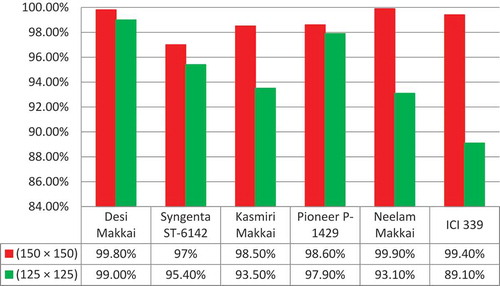
There are some facts to help us of finding good results, as described as follows: (i) Collect the fresh corn seed image dataset, (ii) Focus of preprocessing step, for noise removal and image enhancement, (iii) a novel threshold-based region growing segmentation technique helped us to achieve the goals, (iv) A hybrid-feature dataset was established to conceptualize all scopes of the feature dataset, and (v) Hybrid optimized feature selection helpful using CFS classifier. Finally, the optimize feature of an MLP is that it often delivers better classification on piercing and open gathering atmosphere data .[Citation33] Our experimental work estimates that the dataset containing the most frequently produced corn seed images yielded better results than the current methods. A comparative analysis of the proposed methodology with pervious methodology was described in .
Table 8. Comparison of our proposed approach with existing approaches.
Conclusion
In this study, an automated system has been proposed to classify six varieties of corn seeds with a digital photographic dataset using ML approaches. The objective was to develop and select suitable classifiers (MLP, LB, RF, and BN) and the most effective features for efficient classification. So, we explore classification techniques for six corn seed varieties such as Desi Makkai, Kasmiri Makkai, Neelam Makkai, Syngenta ST-6142, Pioneer P-1429, and ICI 339. The variation of results has been observed due to different environmental factors such as the light of the sun, temperature, illumination, moisture, and various ingredients present in the dataset. We need datasets of sufficient size that can easily control changes in these factors. We hope that the resulting system will open a new horizon to these problems, as well as taking into account computational complexity and time-based issues. All implemented classifier performs well but MLP provides the most effective classification result. We also deal with image processing, threshold-based segmentation hybrid-feature analysis, features extraction, selection, and reduction techniques. We know that in all classification methods, extraction and selection of features play an important role in the overall performance of the classifiers. A large number of features can minimize the accuracy of the classification and maximize the total execution time. That’s why an optimized hybrid-feature dataset has been used for the classification of the corn seed varieties. In the future, we deliberate, to use the difference of the principles in texture features with the sunlight factors in their additional attributes to the same dataset. Also, the next section of this study on the classification of corn seed, without the use of sophisticated systems and expensive equipment, can lead to the identification of corn seed disease through a simple and economical approach.
Acknowledgments
Additionally, authors would like to thank the referees for their careful reading and for their comments, which significantly improved the paper. The authors declare no conflicts of interest.
Additional information
Funding
References
- Flint-Garcia, S. A. 1 Kernel Evolution: From Teosinte to Maize. In Maize Kernel Development, 2017; pp 1.
- Chopin, F.; Roucolle, J. U.S. Patent No. 9,661,820; U.S. Patent and Trademark Office: Washington, DC, 2017.
- Saeed, M. A.; Irshad, A.; Sattar, H.; Andrews, G. E.; Phylaktou, H. N.; Gibbs, B. M. Agricultural Waste Biomass Energy Potential in Pakistan. Proceedings of the International Conference held in Shanghai, PR China, Leeds, October, 2015.
- Lynch, P. J.; Stangland, G. R.; Holland, G. J. U.S. Patent No. 9,072,266; U.S. Patent and Trademark Office: Washington, DC, 2015.
- Sastry, K. S. Methods of Combating Seed-transmitted Virus Diseases. In Seed-borne Plant Virus Diseases; Springer: India, 2013; pp 185–284.
- Liu, K. Soybeans: Chemistry, Technology, and Utilization; Springer, 2012.
- Kamilaris, A.; Prenafeta-Boldú, F. X. Deep Learning in Agriculture: A Survey. Comput. Electron. Agric. 2018, 147, 70–90. DOI: 10.1016/j.compag.2018.02.016.
- Tarabalka, Y.; Benediktsson, J. A.; Chanussot, J.; Tilton, J. C. Multiple Spectral-spatial Classification Approach for Hyperspectral Data. IEEE Transactions on Geoscience and Remote Sensing. 2010. DOI: 10.1109/TGRS.2010.2062526.
- Asif, S.; Ahmad, M.; Zafar, M.; Ali, N. Prospects and Potential of Fatty Acid Methyl Esters of Some Non-edible Seed Oils for Use as Biodiesel in Pakistan. Renewable Sustainable Energy Rev. 2017, 74, 687–702. DOI: 10.1016/j.rser.2017.02.036.
- Altieri, M. A. Agroecology: The Science of Sustainable Agriculture; CRC Press, 2018.
- Mccabe, D.; Kadir, T.; Rodrigues, E. U.S. Patent Application No. 13/304,512, 2018.
- Qadri, S.; Khan, D. M.; Qadri, S. F.; Razzaq, A.; Ahmad, N.; Jamil, M.; Awan, S. A. Multisource Data Fusion Framework for Land Use/land Cover Classification Using Machine Vision. J. Sens. 2017, 2017, 1–8. DOI: 10.1155/2017/3515418.
- Pandey, R.; Naik, S.; Marfatia, R. Image Processing and Machine Learning for Automated Fruit Grading System: A Technical Review. Int. J. Comput. Appl. 2013, 81(16), 29–39. DOI: 10.5120/14209-2455.
- Pourreza, A.; Pourreza, H.; Abbaspour-Fard, M. H.; Sadrnia, H. Identification of Nine Iranian Wheat Seed Varieties by Textural Analysis with Image Processing. Comput. Electron. Agric. 2012, 83, 102–108. DOI: 10.1016/j.compag.2012.02.005.
- Silva, C. S.; Sonnadara, U. Classification of rice grains using neural networks; 2013.
- Pazoki, A. R.; Farokhi, F.; Pazoki, Z. Classification of Rice Grain Varieties Using Two Artificial Neural Networks (MLP and Neuro-Fuzzy). J. Anim. Plant Sci. 2014, 24(1), 336–343.
- Khoshroo, A. L. I. R. E. Z. A.; Arefi, A. R. M. A. N.; Masoumiasl, A. S. A. D.; Jowkar, G. H. Classification of Wheat Cultivars Using Image Processing and Artificial Neural Networks. Agric. Commun. 2014, 2(1), 17–22.
- Shahid, M.; Naweed, M.; Qadri, S. Mutiullah, and EA Rehmani,“Varietal Discrimination of Wheat Seeds by Machine Vision Approach,”. Life Sci. J. 2014, 11(6), 245–252.
- Dubey, B.; Bhagwat, S.; Shouche, S.; Sainis, J. Potential of Artificial Neural Networks in Varietal Identification Using Morphometry of Wheat Grains. Biosyst. Eng. 2006, 95(1), 61–67. DOI: 10.1016/j.biosystemseng.2006.06.001.
- Guevara-Hernandez, F.; Gomez-Gil, J. A Machine Vision System for Classification of Wheat and Barley Grain Kernels. Spanish J. Agric. Res. 2011, 9(3), 9. DOI: 10.5424/sjar/20110903-140-10.
- Chen, X.; Xun, Y.; Li, W.; Zhang, J. Combining Discriminant Analysis and Neural Networks for Corn Variety Identification. Comput. Electron. Agric. 2010, 71, S48–S53. DOI: 10.1016/j.compag.2009.09.003.
- Daskalov, P.; Kirilova, E.; Georgieva, T. Performance of an Automatic Inspection System for Classification of Fusarium Moniliforme Damaged Corn Seeds by Image Analysis. MATEC Web of Conferences. 210, 02014. EDP Sciences, 2018.
- Qiu, G.; Lü, E.; Wang, N.; Lu, H.; Wang, F.; Zeng, F. Cultivar Classification of Single Sweet Corn Seed Using Fourier Transform Near-Infrared Spectroscopy Combined with Discriminant Analysis. Appl. Sci. 2019, 9(8), 1530. DOI: 10.3390/app9081530.
- Li, X.; Dai, B.; Sun, H.; Li, W. Corn Classification System Based on Computer Vision. Symmetry. 2019, 11(4), 591. DOI: 10.3390/sym11040591.
- Zhang, L.; Liu, Z.; Ren, T.; Liu, D.; Ma, Z.; Tong, L.; Zhang, C.; Zhou, T.; Zhang, X.; Li, S. Identification of Seed Maize Fields with High Spatial Resolution and Multiple Spectral Remote Sensing Using Random Forest Classifier. Remote Sens.. 2020, 12(3), 362. DOI: 10.3390/rs12030362.
- Zhang, J.; Dai, L.; Cheng, F. Classification of Frozen Corn Seeds Using Hyperspectral VIS/NIR Reflectance Imaging. Molecules. 2019, 24(1), 149. DOI: 10.3390/molecules24010149.
- Nakata, M.; Miyashita, T.; Kimura, R.; Nakata, Y.; Takagi, H.; Kuroda, M.; … Yamakawa, H. MutMapPlus Identified Novel Mutant Alleles of a Rice Starch Branching Enzyme II B Gene for Fine‐tuning of Cooked Rice Texture. Plant biotechnol. J.. 2018, 16(1), 111–123. DOI: 10.1111/pbi.12753.
- Mishra, D. Computer Vision and Image Processing: Development and Optimization of MATLAB CVIP Toolbox. Doctoral dissertation, Southern Illinois University at Edwardsville, 2018.
- Ali, A.; Qadri, S.; Khan Mashwani, W.; Kumam, W.; Kumam, P.; Naeem, S.; … Sulaiman, M. Machine Learning Based Automated Segmentation and Hybrid Feature Analysis for Diabetic Retinopathy Classification Using Fundus Image. Entropy. 2020, 22(5), 567. DOI: 10.3390/e22050567.
- Naeem, S.; Ali, A.; Qadri, S.; Mashwani, W. K.; Tairan, N.; Shah, H.; … Anam, S. Machine-Learning Based Hybrid-Feature Analysis for Liver Cancer Classification Using Fused (MR and CT) Images. Appl. Sci. 2020, 10(9), 3134. DOI: 10.3390/app10093134.
- Qadri, S.; Khan, D. M.; Ahmad, F.; Qadri, S. F.; Babar, M. E.; Shahid, M.; Ul-Rehman, M.; Razzaq, A.; Shah Muhammad, S.; Fahad, M.; et al. A Comparative Study of Land Cover Classification by Using Multispectral and Texture Data. Biomed Res. Int. 2016, 2016, 1–12. DOI: 10.1155/2016/8797438.
- Qadri, S.; Khan, D.; Ahmad, F.; Qadri, S.; Rehman, M. U.; Muhammad, S.; Ullah, M. A Novel Optimized Land Cover Classification Framework Using Data Mining Techniques. Sindh Univer. Res. J-SURJ (Science Series). 2017, 49(2).
- Qadri, S.; Furqan Qadri, S.; Husnain, M.; Saad Missen, M. M.; Khan, D. M.; Muzammil-Ul-Rehman,; … Ullah, S. Machine Vision Approach for Classification of Citrus Leaves Using Fused Features. Int. J. Food Prop. 2019, 22(1), 2071–2088. DOI: 10.1080/10942912.2019.1703738.

